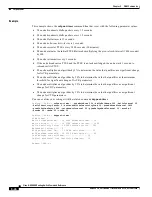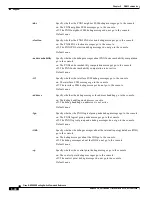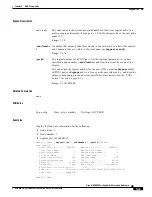
5-56
Cisco MGX 8850 Routing Switch Command Reference
Release 2.0, Part Number 78-10467-04 Rev C0, October 2001
Chapter 5
PNNI Commands
dsppnni-bypass
dsppnni-bypass
Display PNNI Bypasses
—
display the PNNI complex node bypass table.
This debugging command displays the PNNI bypass table for a logical group node (LGN) that uses the
complex node representation of its peer group. The bypass table contains the topology and Hello
information of every node in the peer group.
Note
This command applies to multi-peer groups only.
Cards on Which This Command Runs
PXM45
Syntax
dsppnni-bypass <node-index>
Syntax Description
Display Contents
The display contains the following fields for each node.
node-index
The node index points to the LGN of this peer group. It indicates the relative
level of the node within the hierarchy on the switch. The range is 1–10, and the
lowest level is 1.
Range: 1–10
Default: 1
node-index
The node index indicates the relative level of the logical node within a
multi-peer group on the switch. The supported range is 1–10, and the lowest
level is 1
Input port Id
The logical form of port identifier at the input.
Range: 1–2147483648.
Output port Id
The logical form of port identifier at the output.
Range: 1–2147483648.
ptse id
Display the unique identifier assigned to the PNNI topology state elements
PTSE. ptse-id is the 32 bit numeric node identifier assigned by the software—it
is not user-configurable.
flags
Although a hexadecimal flag appears, it applies to software debugging by Cisco
engineers and so is not described here.
















































